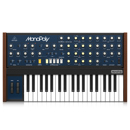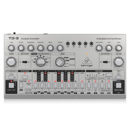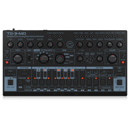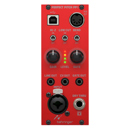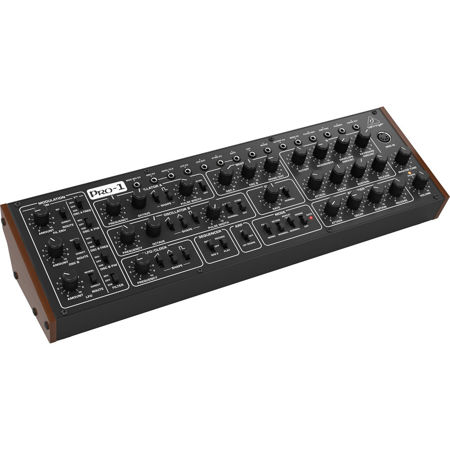
Behringer PRO-1 Semi-Modular Analog Synthesizer with Dual VCOs, 3 Simultaneous Waveforms, 4-Pole VCF, Extensive Modulation Matrix, 16-Voice Poly Chain and Eurorack Format
SKU: BEPRO1
This item is no longer available.
Recommended Alternatives
Share:
Overview
Compare
Accessories
Specs
Protection
Q&A
Questions & Answers
J D : Would you be ok to trade pro1 for k2?
Shopper : Why Did You Choose This?KEITH B : I wanted it
Reviews about this item
Review Summary
2022-03-01T07:24:59
Rated 5 out of 5
Good synth and great price
Well made and it sounds great! I?m happy the Bringer quality has improved over the last ~25 years.
JOHN T.
Select a plan in the Add Protection section above and purchase with this product by clicking “Add to Cart”.
TRUSTED PROTECTION PLANS, EXCEPTIONAL SERVICE.
Invest In Your Gear and Peace Of Mind!
Accidents happen. Protect your favorite Adorama products and purchase a protection plan to stay covered from accidental damage, mechanical or electrical failures, and more.
Repair or Replacement
If we can’t fix it, we’ll replace it at no additional cost.
Accidental Damage
Protect your product from drops, spills, and more.
Peace of Mind
Enjoy your gear without fear. We have you covered!
Failure Protection
When regular use of your product over time results in mechanical or electrical failure.
Zero Deductible
We will never charge you a deductible after the purchase of a plan.
Customer-Focused Support
Our claims process is simple & easy and our customer service team is happy to help.
Adorama Protect powered by Extend is available for purchase to customers in the United States. Not available for international or U.S. territories purchases. Plans on open box items do not cover pre-existing damage.
Adorama Protect plans are available for ABS clients. If you have any questions or require assistanse, please call 800-223-2500
Browse our FAQ
Behringer PRO-1 Specifications
Architecture
Number of Voices: Monophonic
Type of Oscillators: 2 x 3340
Type: Analog
Oscillators: 2 x (32.70 Hz to 8.4 kHz across 4 Ranges)
LFO: 1 (0.08 Hz to 30 Hz)
VCF 1 x 4-Pole Low Pass (24 dB / Octave Slope)
Fixed Routing: Envelopes to VCF to VCAConnectivity
Output: 1/4" / 3.5mm TS, Unbalanced Max. +12 dBu
Headphones: 1/8" / 3.5mm TRS, Unbalanced Max. 7.5 mW at 32 Ohm
Headphones Output Impedance: 8 Ohms
MIDI: In/Thru 2 x 5-Pin DIN / 16 Channels
USB (MIDI): USB 2.0 Type-BUSB
Type: Class Compliant USB 2.0 Type B
Supported Operating Systems:
Windows 7 or Later
Mac OS X 10.6.8 or LaterOscillators
Controls
Frequency (OSC A and B): 0 to 10
Octave: 0, 1, 2 or 3
Pulse Width (OSC A and B): 0 to 10
Switches
Shape (OSC A and B): Sawtooth, Pulse, and Triangular (OSC B only)
OSC A: Sync: On/Off
OSC B: Low Freq or Normal
OSC B: Keyboard or OffModulation
Controls:
From Filt Env: 0 to 10
From OSC B: 0 to 10
From LFO: 0 to 10
Switches:
From Filt Env: Pitch Bend Wheel or Direct
From Osc B: Pitch Bend Wheel or Direct
From LFO: Pitch Bend Wheel or Direct
To OSC A Freq: Pitch Bend Wheel or Direct
To OSC A PW: Pitch Bend Wheel or Direct
To OSC B Freq: Pitch Bend Wheel or Direct.
To OSC B PW: Pitch Bend Wheel or Direct
To Filter: Pitch Bend Wheel or DirectMixer
Controls: OSC A, B and Noise/External Input
Portamento
Controls Rate: 0 to 10
Switches: Auto or NormalLFO
LFO/Clock Section:
Controls: Frequency 0 to 10
Switches: Sawtooth, Triangle, and PulseSequencer
Switches:
Seq 1, Off or Seq 2 (64 note)
Record or PlayArpeggiator
Switches: Up, Off, or Up/Down
Mode
Switches:
Poly or Mono
Retrig or Normal
Repeat/Ext or Normal
Drone or Off
LED: GateFilter
Controls:
Cutoff Frequency: 0 to 10
Resonance: 0 to 10
Env Amount: 0 to 10
KYBD Amount: 0 to 10
Attack: 2.0 ms to 6.5 sec
Decay: 2.0 ms to 15 sec
Sustain: 0 to 5 V
Release: 2.0 ms to 25 secVCA
Controls:
Attack: 2 ms to 6.5 sec
Decay: 2 ms to 15 sec
Sustain: 0 to 5 V
Release: 2 ms to 25 secOutput
Controls:
Volume: 0 to 10
Master Tune: -5 to +5
LED: PowerInputs and Outputs
TS 1/8" / 3.5mm Inputs:
Mod Wheel CV: 0 V to +5 V
OSC CV: -5 V to +5 V
Gate/Clock: More than 2 V (Envelope Triggers at 2 V)
LFO CV: -5 V to +5 V
Ext Input Impedance: 85 kOhm
Cutoff CV: 0 V to +5 V
Resonance CV: 0 V to +5 VInputs and Outputs (Contd.)
TS 1/8" / 3.5mm Outputs:
LFO Out: Triangle: +/-2.5 V
Pulse: +4 V
Sawtooth: +5 V
KB CV: 0 V to +7 V
Gate: 0 V / +5 V
Mixer: 1/8" / 3.5mm TRS, Unbalanced Max. +20 dBu
Filter Env: 0 V to +5 V
Amp Env: 0 V to +5 V
Phones: Signal Output
Audio Out: Signal OutputPower
External Power Adapter: 12 V DC
Power Consumption: 8 W MaximumHorizontal Pitch
80 HP
Operating Temperature
41 to 104 Degree F (5 to 40 Degree C)
Dimensions (H x W x D)
3.7 x 16.7 x 5.4" (9.5 x 42.4 x 13.6cm)
Weight
4 lb (1.8kg)
UPC Code
653341344731
2 Accessories for Behringer PRO-1 Semi-Modular Analog Synthesizer with Dual VCOs, 3 Simultaneous Waveforms, 4-Pole VCF, Extensive Modulation Matrix, 16-Voice Poly Chain and Eurorack Format
- All Accessories (2)
- Stands (1)
- Keyboard Benches (1)
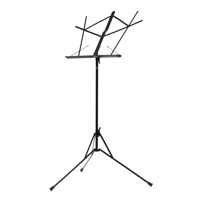
H&A Wire Compact Sheet Music Stand
$19.95
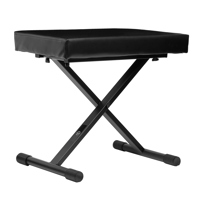
H&A X-Style Piano Bench, Large, Black
$79.99
About Behringer PRO-1
FEATURED REVIEWS
Good synth and great price
By JOHN T.
Well made and it sounds great! I?m happy the Bringer quality has improved over the last ~25 years.
PRO-1
Making its debut in 1981, the monophonic Sequential Circuits Pro-One quickly established itself as the synthesizer of choice for numerous artists including: Thompson Twins, the Prodigy, Depeche Mode, Vince Clarke, New Order, Prince, Soft Cell and a host of others. An ultra-affordable homage to that iconic synthesizer with all the features of the original and then some, the PRO-1 lets you conjure up virtually any sound with incredible finesse and ease. With its pure analog signal path, dual authentic VCOs with 3 selectable waveforms, plus extremely flexible VCF and VCA filters, the PRO-1 is sure to become one of your favorite keyboards. Owning the PRO-1 is like having your own personal time machine, enabling you to embrace the past - or make your imprint on the future!
True to the Original
Great care has been taken in engineering the PRO-1, including the true to the original analog circuitry, legendary VCO, VCF and VCA designs, all of which combine to make it easy to recreate the classic sound performance. This highly-focused attention to detail is what gives the PRO-1 its ultra-flexible sound shaping capability, which covers everything from super-fat bass and lead tones to stunning effects - and all the way out to the otherworldly sounds of your imagination.
Big, Fat Tones
The inspired synthesizer tracks laid down in the 1980s and '90s are etched in the annals of progressive rock, wave, EDM and synth-pop music forever, making them truly classic in every sense of the word. The PRO-1 lets you recreate all of that magic - or design incredibly fat and original sounds that will make you a legend in your own right!
Authentic 3340 Oscillator
PRO-1's 3340 Voltage Controlled Oscillators (VCOs) provides your choice of up to 3 simultaneous waveforms (Oscillator A: Sawtooth and Pulse, Oscillator B: Sawtooth, Triangle and Pulse), with a selectable range of 4 octaves. The VCOs can be modulated via the envelope or the low frequency oscillator (LFO). Performance is further enhanced by the Mixer section, which balances the levels of the internal VCOs and noise generator. This amazing flexibility gives you the tools to be your creative best.
Versatile VCF
The very heart of PRO-1's sound is its classic 4-pole filter, which lets you freely experiment with the Cutoff Frequency, Resonance and Envelope and Keyboard amount, and full complement of ADSR (Attack, Decay, Sustain, Release) controls to dial in the perfect sound. PRO-1's filter Mode switch can be set to either Lo- or Hi-pass for selecting the range of your choice.
16-Note Poly Chain Ready
While it is a monophonic instrument (one note at a time), PRO-1's 16-note Poly Chain function lets you combine multiple synthesizers for up to 16-voice polyphony - plus provides vastly improved reliability and stability over its 1970s and '80s predecessors.
Eurorack Ready
Designed to handle the rigors of life on the road or in the studio, your PRO-1 can easily be transferred into a standard Eurorack case for the perfect integration into your existing system.
Rock Right out-of-the Box!
Your PRO-1 comes ready to rock, thanks to its default signal routing that doesn't require lifting a single patch cable to instantly create amazing sounds. The semi-modular architecture lets you easily tap into the inspired sounds of 1980s and '90s progressive rock, wave, EDM and synth-pop music synthesizer tracks that made rock and roll history - or to design incredibly fat and original sounds that will make you a legend in your own right!
The Envelope, Please...
Make that envelopes! PRO-1's Low Frequency Oscillator (LFO) features your choice of Sawtooth, Triangle and Pulse waveforms with a sweepable frequency range from 0.1 to 30 Hz - plus 2 separate Envelope generators for modulating the VCF and VCA.
Onboard Sequencer & Arpeggiator
PRO-1's dual 64-note sequencers allow you to record and playback your choice of 2 unique patterns, which can be played either in Keyboard mode, where you create and store the pattern, or Step mode, which allows you to interact while composing the pattern. The onboard Arpeggiator switch features 3 positions, Up (ascending), Down (descending) and Off. Both sequencers and the arpeggiator are fun, mesmerizing and totally addictive...
The LFO, the Matrix & More...
Thanks to its dedicated and fully-analog LFO, PRO-1 lets you choose from triangle, pulse or square waveforms and features a single Frequency control for ultra-easy operation. Additionally, the onboard Modulation matrix lets you set the Amount of Filter Envelope, Oscillator B and LFO modulation is applied to the signal, and how. You can even modulate the pulse wave via the LFO, envelope or manually - for sounds ranging from mild to wild!
Controls & Connectivity
We just can't help ourselves - like you, we're gear-heads, too. For those who want the numbers, PRO-1 has 56 controls, all laid out in a highly-intuitive format that puts the joy back into your music creation. And you can expand PRO-1's tone-sculpting capabilities beyond your wildest dreams by utilizing the patchbay for incredibly vast and flexible patching options!
Unleash Your Imagination
When it comes to not just pushing envelopes but creating them, PRO-1 gives your imagination its voice - and it's so very affordable. When modern performance calls for classic analog sound - it calls for the Behringer PRO-1!Visit your dealer to experience the stunning PRO-1 or get yours online today. MUSIC never felt this good
A Brief History of Analog Synthesis
The modern synthesizer's evolution began in 1919, when a Russian physicist named Lev Termen (also known as Leon Theremin) invented one of the first electronic musical instruments - the Theremin. It was a simple oscillator that was played by moving the performer's hand in the vicinity of the instrument's antenna. An outstanding example of the Theremin's use can be heard on the Beach Boys iconic smash hit "Good Vibrations".
Ondioline
In the late 1930s, French musician Georges Jenny invented what he called the Ondioline, a monophonic electronic keyboard capable of generating a wide range of sounds. The keyboard even allowed the player to produce natural-sounding vibrato by depressing a key and using side-to-side finger movements. You can hear the Ondioline on Del Shannon's "Runaway".
Storytone Piano
Designed by famous piano manufacturer Story & Clark in association with RCA, the Storytone piano debuted at the 1939 New York World's Fair. Hailed as the world's first electric piano, the Storytone is prized by musicians and collectors alike for its realistic piano sound - only 500 or so were ever built.
Mellotron
Finding a high level of acceptance in the 1960s, Harry Chamberlin's Mellotron was an electro-mechanical keyboard that generated sounds by playing back pre-recorded tape loops. Although tempermental and prone to pitch and mechanical issues, the Mellotron was used extensively by many U.K. artists. Classic tracks from the Moody Blues "Days of Future Passed", the Beatles "Strawberry Fields Forever", and the Rolling Stones "She's a Rainbow" are prime examples. Attribute author: By Buzz Andersen from San Francisco, California, United States Mellotron | NAMM 2007
ARP 2600
Manufactured by ARP Instruments, Inc., the Arp 2600 was one of the most successful synthesizers to come out of the 1970s. They were ideal for players new to the synth world, and allowed patches to be changed via switches or 1/8" audio cables. The list of recordings and artists that used the venerable Arp 2600 reads like a veritable Who's Who of rock, pop and jazz, and includes The Who, David Bowie, John Lennon, Depeche Mode, Edgar Winter, Frank Zappa and Herbie Hancock - to name just a few. An Arp 2600 was even used to create the voice of the Star Wars character R2-D2.
Minimoog
Designed to replace the large, modular synths being used in pop music at the time, Bill Hemsath and Robert Moog developed the Minimoog in 1971. The monophonic instrument became the first truly all-in-one, portable analog synthesizer. Thanks to its 3 oscillators and 24 dB/octave filter, the Minimoog produces an extremely rich and powerful bass sound and is still in high demand today. Yes keyboardist Rick Wakeman said the instrument "absolutely changed the face of music." Attribute author: glacial23 - Early Minimoog Uploaded by clusternote, CC BY-SA 2.0
Yamaha CS-80
In 1976, Yamaha released their CS-80 8-voice polyphonic synthesizer, which provided velocity-sensitive keys and aftertouch that worked on individual voices. The analog instrument featured a ribbon controller, which allowed the user to perform polyphonic pitch bends and smooth glissandos. Composer Vangelis used the CS-80 extensively in the Blade Runner and Chariots of Fire soundtracks. The CS-80 also provided the bass line heard in the BBC 1980 series Doctor Who theme song. Image attribution: Pete Brown from Gambrills, MD, USA
Sequential Circuits Prophet 5
Sequential Circuits introduced the Prophet 5, which was the first analog 5-voice polyphonic synthesizers to provide onboard memory storage of all patch settings for instant recall. The great-sounding Prophet 5 revolutionized the synthesizer world and, in spite of its rather expensive price tag, became one of the most successful synths of all time. Designed by Dave Smith and J owen, the Prophet 5 was the keyboard of choice by a very long list of performers that includes Peter Gabriel, Philip Glass, Journey, The Cars, Thomas Dolby, Duran Duran, Gary Numan, Pink Floyd, and countless others. Image attribution: original uploader was Felix2036 at Dutch Wikipedia derivative work: Clusternote
Behringer PRO-1 Features
- Amazing analog synthesizer with dual VCO design allows for amazingly fat music creation
- Authentic reproduction of original circuitry with legendary 3340 and 3320 semiconductors
- Pure analog signal path based on authentic VCO, VCF and VCA designs
- 3 simultaneous oscillator shapes (OSC A: Saw / Pulse, OSC B: Saw / Triangle / Pulse waveforms)
- Classic 4-pole filter design with self-resonance capability
- Powerful modulation matrix for 2 modulation buses for flexible music creation
- Dedicated and analog LFO with simultaneous Sawtooth, Triangle and Square oscillator shapes
- 2 envelope generators for modulation of VCF and VCA
- Easy-to-use 64-note dual sequencer (LFO clock serves as master clock)
- Arpeggiator with 3 patterns for great sound effects
- 16-voice Poly Chain allows combining multiple synthesizers for up to 16 voice polyphony
- Complete Eurorack solution? main module can be transferred to a standard Eurorack case
- 56 controls give you direct and real-time access to all important parameters
- Audio input for processing external sound sources for enhanced creativity
- External control inputs and outputs (Gate, Filter etc.)
- Comprehensive USB/MIDI implementation with MIDI channel and Voice Priority selection
- Designed and engineered in the U.K
Key Features
- Amazing analog synthesizer with dual VCO design allows for amazingly fat music creation
- Authentic reproduction of original circuitry with legendary 3340 and 3320 semiconductors
- Pure analog signal path based on authentic VCO, VCF and VCA designs
- 3 simultaneous oscillator shapes (OSC A: Saw / Pulse, OSC B: Saw / Triangle / Pulse waveforms)
- Classic 4-pole filter design with self-resonance capability
- Powerful modulation matrix for 2 modulation buses for flexible music creation
What's in the box:
- Behringer PRO-1 Semi-Modular Analog Synthesizer
- Power Supply
- Adorama 1 Year Limited Warranty
